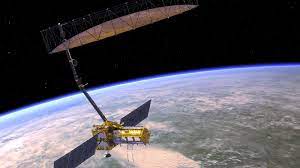NASA-ISRO NISAR Mission:

Indian Space Research Organisation (ISRO) is working with the National Aeronautics and Space Administration (NASA) of the United States of America to jointly realise a satellite mission named ‘NASA-ISRO Synthetic Aperture Radar (NISAR)’ for scientific studies of Earth.
- The NISAR mission is scheduled for launch in 2023.
- NISAR is optimised for studying hazards and global environmental change and can help manage natural resources better and provide information to scientists to better understand the effects and pace of climate change.
- It will scan the globe every 12 days over the course of its three-year mission of imaging the Earth’s land, ice sheets and sea ice to give an “unprecedented” view of the planet.
- It will detect movements of the planet’s surface as small as 0.4 inches over areas about half the size of a tennis court.
- NASA will provide one of the radars for the satellite, a high-rate communication subsystem for science data, GPS receivers and a payload data subsystem.
- ISRO will provide the spacecraft bus, the second type of radar (called the S-band radar), the launch vehicle and associated launch services.
- NISAR will be equipped with the largest reflector antenna ever launched by NASA and its primary goals include tracking subtle changes in the Earth’s surface, spotting warning signs of imminent volcanic eruptions, helping to monitor groundwater supplies and tracking the rate at which ice sheets are melting.
- The name NISAR is short for NASA-ISRO-SAR. SAR here refers to the synthetic aperture radar that NASA will use to measure changes in the surface of the Earth.
- Essentially, SAR refers to a technique for producing high-resolution images.
- Because of the precision, the radar can penetrate clouds and darkness, which means that it can collect data day and night in any weather.




